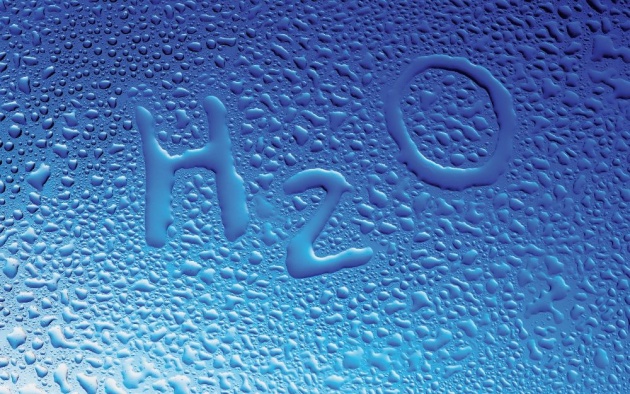WATER
Water (chemical formula: H2O) is a transparent fluid which forms the world's streams, lakes, oceans and rain, and is the major constituent of the fluids of organisms. As achemical compound, a water molecule contains one oxygen and two hydrogen atoms that are connected by covalent bonds. Water is a liquid at standard ambient temperature and pressure, but it often co-exists on Earth with its solid state, ice; and gaseous state, steam (water vapor). It also exists as snow, fog, dew and cloud.
Water covers 71% of the Earth's surface.[1] It is vital for all known forms of life. On Earth, 96.5% of the planet's crust water is found in seas and oceans, 1.7% in groundwater, 1.7% in glaciers and the ice caps of Antarctica and Greenland, a small fraction in other large water bodies, and 0.001% in the air as vapor, clouds (formed of ice and liquid water suspended in air), and precipitation.[2][3] Only 2.5% of this water is freshwater, and 98.8% of that water is in ice (excepting ice in clouds) and groundwater. Less than 0.3% of all freshwater is in rivers, lakes, and the atmosphere, and an even smaller amount of the Earth's freshwater (0.003%) is contained within biological bodies and manufactured products.[2] A greater quantity of water is found in the earth's interior.[4]
Water on Earth moves continually through the water cycle of evaporation and transpiration (evapotranspiration), condensation, precipitation, and runoff, usually reaching the sea. Evaporation and transpiration contribute to the precipitation over land. Water used in the production of a good or service is known as virtual water.
Safe drinking water is essential to humans and other lifeforms even though it provides no calories or organic nutrients. Access to safe drinking water has improved over the last decades in almost every part of the world, but approximately one billion people still lack access to safe water and over 2.5 billion lack access to adequate sanitation.[5] There is a clear correlation between access to safe water and gross domestic product per capita.[6] However, some observers have estimated that by 2025 more than half of the world population will be facing water-based vulnerability.[7] A report, issued in November 2009, suggests that by 2030, in some developing regions of the world, water demand will exceed supply by 50%.[8] Water plays an important role in the world economy, as it functions as a solvent for a wide variety of chemical substances and facilitates industrial cooling and transportation. Approximately 70% of the freshwater used by humans goes to agriculture
: one molecule of water has two hydrogen atoms covalently bonded to a single oxygen atom.
Water appears in nature in all three common states of matter (solid, liquid, and gas) and may take many different forms on Earth: water vapor and clouds in the sky, seawaterin the oceans, icebergs in the polar oceans, glaciers in the mountains, fresh and salt water lakes, rivers, and aquifers in the ground.
The major chemical and physical properties of water are:
Water is a liquid at standard temperature and pressure of 273.15 K (0 °C, 32 °F) and an absolute pressure of exactly 100 000 Pa (1 bar, 14.5 psi, 0.98692 atm). It is tasteless and odorless. The intrinsic color of water and ice is a very slight blue hue, although both appear colorless in small quantities. Water vapour is essentially invisible as a gas.[10]
Water is transparent in the visible electromagnetic spectrum. Thus aquatic plants can live in water because sunlight can reach them. Infrared light is strongly absorbed by the hydrogen-oxygen or OH bonds.
Since the water molecule is not linear and the oxygen atom has a higher electronegativity than hydrogen atoms, the oxygen atom carries a slight negative charge, whereas the hydrogen atoms are slightly positive. As a result, water is a polar molecule with an electrical dipole moment. Water also can form an unusually large number of intermolecular hydrogen bonds (four) for a molecule of its size. These factors lead to strong attractive forces between molecules of water, giving rise to water's high surface tension[11] and capillary forces. The capillary action refers to the tendency of water to move up a narrow tube against the force of gravity. This property is relied upon by allvascular plants, such as trees.[12]
Water is a good polar solvent and is often referred to as the universal solvent. Substances that dissolve in water, e.g., salts, sugars, acids, alkalis, and some gases – especially oxygen and carbon dioxide (carbonation) – are known as hydrophilic (water-loving) substances, while those that are immiscible with water (e.g., fats and oils), are known as hydrophobic (water-fearing) substances.
All of the components in cells (proteins, DNA and polysaccharides) are dissolved in water, deriving their structure and activity from their interactions with the water.
Pure water has a low electrical conductivity, but this increases with the dissolution of a small amount of ionic material such as sodium chloride.
The boiling point of water (and all other liquids) is dependent on the ambient pressure. For example, on the top of Mount Everest water boils at 68 °C (154 °F), compared to 100 °C (212 °F) at sea level at a similar latitude (since latitude modifies atmospheric pressure slightly). Conversely, water deep in the ocean near geothermal vents can reach temperatures of hundreds of degrees and remain liquid.
At 4181.3 J/(kg·K), water has a high specific heat capacity, as well as a high heat of vaporization (2257 kJ/kg), both of which are a result of the extensive hydrogen bondingbetween its molecules. These two unusual properties allow water to moderate Earth's climate by buffering large fluctuations in temperature.
The density of liquid water is 1,000 kg/m3 (62.43 lb/cu ft) at 4 °C. Ice has a density of 917 kg/m3 (57.25 lb/cu ft).



